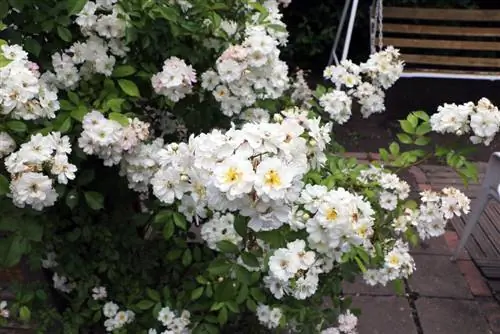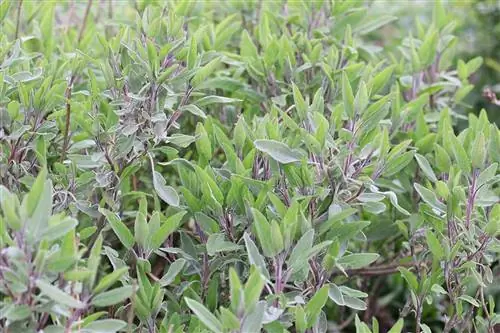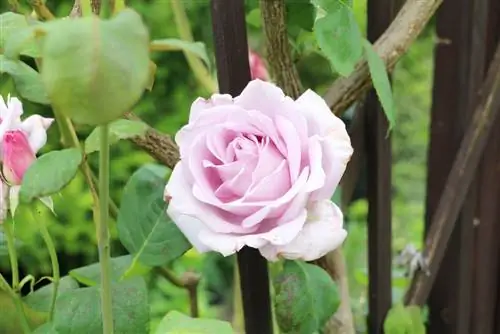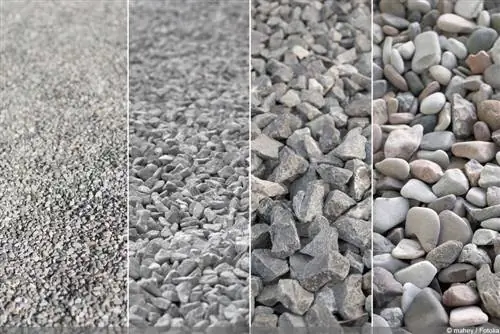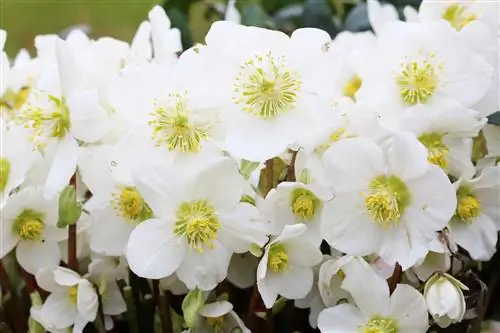- Author admin [email protected].
- Public 2023-12-17 03:39.
- Last modified 2025-01-24 12:45.
The tufted rose is described by some as easy to care for and by others as demanding. That's probably a matter of interpretation. It can't do without any care at all, but it doesn't need too much care. The waste can also be omitted from time to time. However, if this fails completely, baldness can occur. In this respect, Rosa multiflora does not differ from the requirements of other plants. Interested hobby gardeners will find out below exactly what care should look like and what is important when it comes to cuttings.
Location
The tufted rose comes from East Asia and is primarily found on slopes, on stony but nutrient-rich soils. It also grows in both the sun and partial shade and is an important source of food for insects due to its abundance of flowers. The summer green plant can withstand frost and wind well due to its origin. Important factors for the location in the garden are derived from the origin and the circumstances:
- loamy, gravelly or sandy soils
- Sun to partial shade
- not sensitive to wind
- attracts insects and should therefore not be too close to the house
Of course, when choosing where to plant the Rosa multiflora, its size should also be taken into account. Without reducing trimmings, the tufted rose can reach a height of up to four or even five meters and a width of two to three meters. If you want to let it grow as unhindered as possible and enjoy the abundance of flowers on a large scale, you should provide it with enough space. In these cases, trellises are also suitable for stabilization. Sunny locations are also preferable, as the multi-flowered rose usually produces more flowers.
Substrate
As mentioned, the tufted rose prefers a loamy substrate as a base. To ensure that it does not become compacted but remains loose, sand or clay should be added to it. The soil must be nutrient-rich and not excessively wet, loose and crumbly. A mixture of garden soil and loosening material is well suited. The heavier the substrate is and the more it tends to compact, the higher the proportion of sand or gravel should be. The pH value should be between 4 and 6.
Of course, water drainage must also be ensured. Locations with very high groundwater or a direct proximity to the garden pond can prove to be problematic.
Tip:
If the soil is dry, we recommend applying bark mulch or gravel. This pad reduces evaporation and also helps keep weeds at bay.
Plants
The tufted rose can be planted both in autumn and spring. Plants planted in autumn often produce flowers the following summer. This is less common when the multi-flowered rose is planted in spring. However, there are no other points to consider here. The Rosa multiflora is planted so that the roots are well covered. The ground should be free of frost.
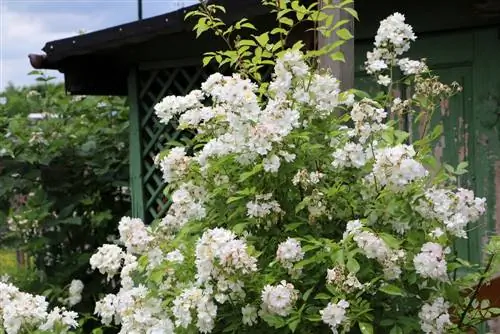
As a “start-up aid” for the development of roots, growth and shoots, the planting hole can be filled with a mixture of the substrate described and an organic fertilizer, such as well-rotted compost. In the first few weeks, greater care must be taken to ensure that the soil does not dry out. Although waterlogging should be avoided, excessive watering can stimulate root formation.
Pouring
Here the tufted rose does not have any high demands once it has grown. Planted outdoors usually only needs to be watered during dry periods and for fertilization. Watering here can be done quite sparingly and only serves to dissolve nutrients and prevent them from drying out completely. Rainwater would of course be ideal. Alternatively, soft tap water can also be used. If these two options are not available, it is advisable to leave the water for the multi-flowered rose for a week.
Tip:
Water from the garden pond or aquarium can also be used for occasional watering and light fertilization. Of course, the prerequisite here is that the water has not been treated chemically.
Fertilize
Approximately from April to August, monthly fertilization can be carried out. Mineral and organic fertilizers can be used. It is important that the soil be examined before using fertilizers. In this way, the optimal remedy can be found and over-fertilization can be avoided.
However, the following are generally suitable:
- Rose fertilizer
- well-rotted compost
- organic NPK fertilizer
- Flowering fertilizer
- Coffee grounds
- Horn shavings
- Aquarium or pond water
- Plant manure, for example from nettles
If there are no significant deficiencies of certain nutrients in the soil, the fertilizers can also be alternated. Pond water one month, some coffee grounds or some plant manure the next. In this way, the plant is supplied with a wide range of nutrients.
An alternative to monthly fertilization are long-term fertilizers that are specifically tailored to the needs of roses or flowering shrubs.
Solid nutrients are easily incorporated into the top soil or can be added to irrigation water. Watering after fertilization is just as important for the tufted rose as for all other plants. Otherwise, the nutrients may not be distributed evenly and, in the worst case, lead to chemical burns.
Tip:
If you have already mixed fertilizer into the soil when planting the Rosa multiflora, you save yourself the additional nutrient supply during the first season. Fertilization usually only has to be carried out in the second year.
Bucket Culture
As mentioned above, the tufted rose can grow into quite a tall and wide bush. Nevertheless, it is well suited for cultivation in a container within the first few years. If it is trimmed regularly and repotted as needed or the soil is replaced, it can also be grown permanently in the container.
However, in this case, some special care considerations should be taken into account. These are:
- ensure good water drainage to prevent waterlogging
- fertilization monthly, as the small amount of substrate means fewer nutrients are available than in the open field
- blend twice annually to control size
- carry out a soil change every year or every two years
Wintering
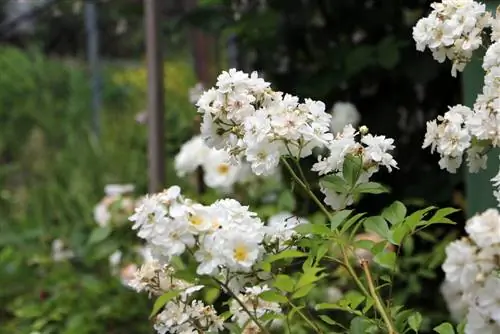
Overwintering the tufted rose outdoors is usually possible without any problems, because the Rosa multiflora is hardy down to temperatures of -29 °C. However, some protection should be provided for young plants that have just been planted. The same applies to culture inKübel
It is important in these cases:
- to wrap the above-ground shoots with garden fleece, straw mats or jute
- to apply a layer of straw, brushwood or bark mulch to the soil
- also wrap the bucket with garden fleece or suitable materials
- Protect the roots in the planter from frost from below, for example by placing them on Styrofoam or a pallet
As an alternative to these measures, the bush rose can also be overwintered indoors. It is important to ensure that the substrate does not dry out completely and that the plant is not completely dark, cold but as frost-free as possible.
Blend
When cutting the tufted rose, there are three different variants:
- Thinning before flowering
- Pruning after flowering
- Radical cut or tapering cut
When the rose multiflora sprouts again after winter but before it sets buds, dead and cross-growing shoots are cut off. The multi-flowered rose is considered to be light. If you prefer a particularly bushy and dense look, you can simply remove dead sections. The flowers appear from June to July on both this year's and annual shoots. Once these have faded, rose scissors are used again. This time, however, more cautiously. Only the withered shoots are removed.
The radical cut is only necessary if the bush rose begins to go bald or has shot up uncontrollably - i.e. if the gentler care cuts have not been carried out for a few years. Radical pruning is also easily tolerated by he althy bush roses. All shoots are cut off just above the ground. The measure can take place both in spring and autumn.
Conclusion
If you do a little care and make a trimming every year, you will enjoy the tufted rose for a long time. Since it serves as a bee pasture and bird protection, the wildlife in the garden also benefits from it. The Rosa multiflora is a relatively easy-care asset and can even serve as a privacy screen due to its size and density.

